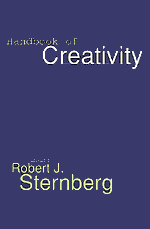Book contents
- Frontmatter
- Contents
- List of Contributors
- Preface
- Handbook of Creativity
- PART I INTRODUCTION
- PART II METHODS FOR STUDYING CREATIVITY
- 3 Psychometric Approaches to the Study of Human Creativity
- 4 Experimental Studies of Creativity
- 5 The Case Study Method and Evolving Systems Approach for Understanding Unique Creative People at Work
- 6 Creativity from a Historiometric Perspective
- PART III ORIGINS OF CREATIVITY
- PART IV CREATIVITY, THE SELF, AND THE ENVIRONMENT
- PART V SPECIAL TOPICS IN CREATIVITY
- PART VI CONCLUSION
- Author Index
- Subject Index
5 - The Case Study Method and Evolving Systems Approach for Understanding Unique Creative People at Work
Published online by Cambridge University Press: 05 June 2014
- Frontmatter
- Contents
- List of Contributors
- Preface
- Handbook of Creativity
- PART I INTRODUCTION
- PART II METHODS FOR STUDYING CREATIVITY
- 3 Psychometric Approaches to the Study of Human Creativity
- 4 Experimental Studies of Creativity
- 5 The Case Study Method and Evolving Systems Approach for Understanding Unique Creative People at Work
- 6 Creativity from a Historiometric Perspective
- PART III ORIGINS OF CREATIVITY
- PART IV CREATIVITY, THE SELF, AND THE ENVIRONMENT
- PART V SPECIAL TOPICS IN CREATIVITY
- PART VI CONCLUSION
- Author Index
- Subject Index
Summary
INTRODUCTION
In the evolving systems approach to the case study method, there are three guiding ideas: The creative person is unique, developmental change is multidirectional, and the creative person is an evolving system. The necessary uniqueness of the creative person argues against efforts to reduce psychological description to a fixed set of dimensions. The creative person is not conveniently “far out” along some well-charted path: She or he is unique in unexpected ways. Indeed, it may never be possible to make more than a few obvious generalizations about ways in which all creative people are alike.
The prevailing image of psychological change in developmental theory unfortunately is one of unilinear, cumulative, predictable, and irreversible growth in accordance with a species-general standard sequence. For those using the evolving systems approach, however, development is not restricted to a unilinear pathway since an evolving system does not operate as a linear sequence of cause-effect relationships but displays, at every point in its history, multicausal and reciprocally interactive relationships both among the internal elements of the system and between the organism and its external milieu. Whether change is cumulative and whether it is structurally developmental or not must be worked out in each instance by investigators.
- Type
- Chapter
- Information
- Handbook of Creativity , pp. 93 - 115Publisher: Cambridge University PressPrint publication year: 1998
- 22
- Cited by



